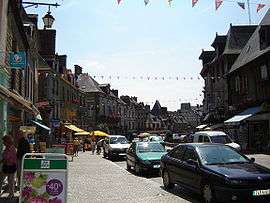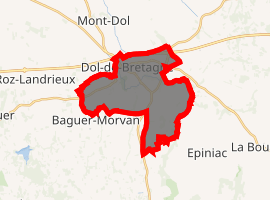Dol-de-Bretagne
Dol-de-Bretagne (Breton: Dol, Gallo: Dóu), cited in most historical records under its Breton name of Dol, is a commune in the Ille-et-Vilaine département in Brittany in northwestern France.
Dol-de-Bretagne Dol | |
|---|---|
 La Grande Rue | |
.svg.png) Coat of arms | |
Location of Dol-de-Bretagne 
| |
 Dol-de-Bretagne  Dol-de-Bretagne | |
| Coordinates: 48°33′02″N 1°44′59″W | |
| Country | France |
| Region | Brittany |
| Department | Ille-et-Vilaine |
| Arrondissement | Saint-Malo |
| Canton | Dol-de-Bretagne |
| Intercommunality | Pays de Dol-de-Bretagne |
| Government | |
| • Mayor (2014–2020) | Denis Rapinel |
| Area 1 | 15.53 km2 (6.00 sq mi) |
| Population (2017-01-01)[1] | 5,693 |
| • Density | 370/km2 (950/sq mi) |
| Time zone | UTC+01:00 (CET) |
| • Summer (DST) | UTC+02:00 (CEST) |
| INSEE/Postal code | 35095 /35120 |
| Elevation | 1–58 m (3.3–190.3 ft) (avg. 17 m or 56 ft) |
| 1 French Land Register data, which excludes lakes, ponds, glaciers > 1 km2 (0.386 sq mi or 247 acres) and river estuaries. | |
History
.jpg)
Dol is a Breton term meaning "low and fertile place in the flood plain of a waterway;" cf. Welsh dôl ("meadow").[2]
In 549, the Welsh Saint Teilo was documented as coming to Dol where he joined Samson of Dol, and the fruit groves which they planted remain and are known as the groves of Teilo and Samson.[3] Legend has it that while there he was assigned by King Budic II to subdue a belligerent winged dragon, which he was said to have tamed and then tied to a rock in the sea off Brittany.[3] He is reported to have stayed in Dol for seven years and seven months so must have left in 556 or 557.
Dol-de-Bretagne is reputed to be the origin of the royal House of Stewart who became the monarchs of Scotland and later England and Ireland; a plaque in Dol commemorates that origin. The Stewart monarchs descend from Alan the Seneschal of the Bishop of Dol. His son, Flaad Fitzalan and his son Alan, arrived in Britain at the request of Henry I, King of England. Flaad's grandson, Walter Fitzalan, was appointed the 1st Steward of Scotland by David I of Scotland. Malcolm IV of Scotland later confirmed the honour bestowed by David and made the office of Steward of Scotland hereditary in Walter's family. In the fourteenth century, Walter Stewart (so named for his family's hereditary possession of the office of High Steward of Scotland), a descendant of Walter Fitzalan, married Marjorie Bruce, daughter of King Robert I of Scotland. Their son became King Robert II, and their descendants the royal House of Stewart.
Dol figured prominently in the formation and evolution of the Duchy of Brittany. Nominoe, the ruler of Brittany attempted to establish a Patriarch for the Breton church in a move to give it autonomy, and thereby strengthen his rule and further secure his independence from the Carolingian Empire. It took centuries for Rome to recognize the Archbishop of Dol. However, after the formation of the Duchy of Brittany in 939, the Archbishop of Dol often wielded great political power and was even at one time Regent to a young Duke of Brittany. Dol Cathedral is a significant building in an eclectic mix of styles. The diocese was suppressed in 1801.
The town was unsuccessfully besieged by William the Conqueror, and taken by Henry II of England in 1164.[4] In June 1173 Hugh de Kevelioc, 5th Earl of Chester, laid siege to Dol-de-Bretagne and captured the settlement as part of the Revolt of 1173–1174 against Henry. Henry, supported by an army of 20,000 mercenaries retook Dol-de-Bretagne the same year.[5] The town was again taken by Guy of Thouars in 1204.[4]
Located near the town is Cricket Club Des Ormes,[6] which in 2003 set a world record for the longest cricket match. The club played for 26 hours and 13 minutes. The record has been beaten a number of times since.
Population
Inhabitants of Dol-de-Bretagne are called Dolois in French.
| Year | Pop. | ±% |
|---|---|---|
| 1962 | 4,483 | — |
| 1968 | 4,497 | +0.3% |
| 1975 | 4,624 | +2.8% |
| 1982 | 4,660 | +0.8% |
| 1990 | 4,629 | −0.7% |
| 1999 | 4,563 | −1.4% |
| 2008 | 5,163 | +13.1% |
Cultural legacy
Dol is home to a number of significant heritage sites, including a 12th-century house.[7]
In literature
Dol is one of the settings for a lai by Marie de France; Gurun, lord of Dol, is one of the main characters in "Le Fresne".[8]
Gallery
_Mairie.jpg) Town hall
Town hall Rue Ceinte
Rue Ceinte Saint Samson cathedral
Saint Samson cathedral
See also
- Communes of the Ille-et-Vilaine department
- List of megalithic sites
- André César Vermare Sculptor of war memorial in cathedral.
References
- "Populations légales 2017". INSEE. Retrieved 6 January 2020.
- "Celtic Culture: A-Celti". ABC-CLIO. July 27, 2006 – via Google Books.
- "Who was St Teilo?". Stteilosbishopton.co.uk. Archived from the original on 20 July 2011. Retrieved 29 March 2011.
-

- Flori 1999, p. 33.
- Cricket Club Des Ormes
- "Maison: Bretagne ; Ille-et-Vilaine ; Dol-de-Bretagne". Retrieved 2 July 2015.
- Dearnley, Elizabeth D. (10 September 2013). "'Celtic mystique': The geographical settings of lais". Mapping the European Breton Lai. University College London. Retrieved 2 July 2015.
Bibliography
- Flori, Jean (1999). Richard the Lionheart: Knight and King. Jean Birrell. Edinburgh: Edinburgh University Press. ISBN 978-0-7486-2047-0.CS1 maint: ref=harv (link)
External links
| Wikimedia Commons has media related to Dol-de-Bretagne. |
- Official website (in French)
- Cultural Heritage (in French)